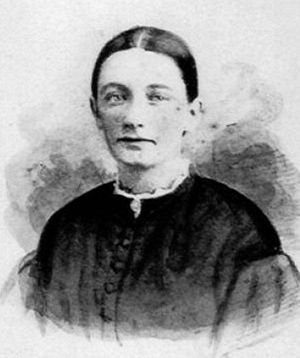Cornelia Hancock facts for kids
Quick facts for kids
Cornelia Hancock
|
|
|---|---|
 |
|
| Born | 8 February 1840 Hancock's Bridge, New Jersey, US
|
| Died | 31 December 1927 (aged 87) |
| Resting place | Cedar Hills Friends Cemetery in Harmersville, New Jersey |
| Nationality | American |
| Occupation | Nurse |
| Years active | 1863–1865 |
| Known for | Civil War nurse |
Cornelia Hancock (born February 8, 1840 – died December 31, 1927) was a brave volunteer nurse. She helped injured and sick soldiers during the American Civil War. Cornelia served the Union Army from July 1863 to May 1865.
Contents
Early Life and Family
Cornelia Hancock was born in Hancock's Bridge, New Jersey. Her family were Quakers. She was the youngest of four children. Cornelia went to school in Salem County academies. Her sister Ellen worked at the United States Mint in Philadelphia. Cornelia's brother and cousins joined the Union Army in 1862.
Serving in the Civil War
Getting to Gettysburg
Cornelia got her chance to help in July 1863. Her brother-in-law, Henry T. Child, was a volunteer surgeon. He offered to take her to the Gettysburg Battlefield.
However, Dorothea Dix was in charge of Union Army nurses. She said Cornelia could not be a nurse. Dix thought Cornelia was too young at 23 years old. She also believed Cornelia was too attractive. Dix wanted nurses to be older and "plain." Cornelia was the only volunteer nurse turned away.
Helping at Gettysburg
But Cornelia went to Gettysburg anyway. She arrived on July 6, 1863. The need for help was so great that no one cared about her age. She wrote in her journal about the urgent situation. In a letter, she said she would never be scared again.
Cornelia had no special nurse training. Yet, she helped many wounded soldiers. After three weeks, she was caring for most of the injured. In October, she also helped many hungry and hurt escaped slaves. They were arriving in Washington, D.C.
Working with the II Corps
On February 10, 1864, Cornelia joined the II Corps. She worked at their hospital near Brandy Station, Virginia. She also served during the Battle of the Wilderness. Later, she helped at the Siege of Petersburg. Cornelia worked at the II Corps hospital in City Point.
After the War
Helping Others in the South
After the war ended, Cornelia continued to help people. She opened a school for African Americans in Mount Pleasant, South Carolina. This was a big step in helping former slaves get an education.
Charity Work in Philadelphia
Cornelia also started several charity groups in Philadelphia. She was on the board of the Children's Aid Society. This was from 1883 to 1895. She helped children who lost their parents after the Johnstown Flood. She also became president of the National Association of Army Nurses of the Civil War. This group supported nurses who served in the war.
Later Life and Legacy
In 1914, Cornelia retired. She moved to Atlantic City to live with her niece. She passed away in 1927. Her ashes were buried in Harmersville, New Jersey.
Cornelia's letters from the war were very popular. They shared her experiences as a nurse. A special flagstone was placed in her honor. It is at the Lower Alloways Creek Friends Meeting House.

